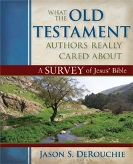Reviewed by John Ronning
Deriving spiritual benefit from the OT can be a daunting challenge, whether one is a beginner or more experienced reader. If there is cultural, historical and other kinds of “distance” between us and the NT world, not to mention theological distance for new believers, how much more so when it comes to the OT. Thus the need for a well written survey of OT material from a Conservative Evangelical perspective, preferably one suitable as a textbook for a one semester OT Survey course, or for personal and group Bible study. As such I think this survey is quite suitable. How to avoid distraction by all sorts of material that seems foreign, odd, pointless, etc? The title’s implied answer is to focus on what the authors “really cared about.” The project is helped by the fact that the 17 contributors are experienced teachers at 14 different respected conservative evangelical schools across North America; experienced at helping students profit most from their OT studies.
Approach
The OT is treated from the perspective of progressive revelation, so that not only is there a development of God’s plan and purpose throughout the OT period, but the OT is constantly treated as laying a foundation for the NT fulfillment. Page 51 summarizes the Bible’s message as “God’s kingdom through covenant for his glory in Christ,” which I think works pretty well. An initial introductory chapter is followed by three sections corresponding to the law, the prophets, and the writings, each with a section introduction. The 39 books are dealt with in 24 chapters, combining books in a manner similar to the numbering of Josephus (e.g. the 12 “minor” prophets are covered in 1 chapter).
Features
Material felt to be of most importance is highlighted in a number of ways. Each chapter begins with the text of well-selected “carefully crafted verses from” the book(s) under discussion; verses presumably of first importance in memorization with a view to getting a handle on the book’s content. One would probably disagree here and there with the author’s choice – e.g. Joshua 1:8-10, which functions as a key to understanding the whole book and is greatly edifying to the modern believer, is omitted (p. 173)?
The chapters also begin with discussions of the questions Who (author)? When? Where? Why? Such questions serve as a good introduction before reading the chapter as well as a good place to return for review at the end (and if used as a textbook, a guide for exam material). Numerous summary figures are provided, many with an “at a glance” in their title, which serve to helpfully summarize for the reader the main points around which to organize book content. There are of course also maps throughout to help visualize narrative events. Numerous photographs are also provided to help the reader bridge the distance mentioned above.
KINGDOM is used as an acronym to divide the OT and NT into periods: Kickoff and rebellion (Genesis 1-11); Instrument of blessing (patriarchal period); Nation redeemed and commissioned (exodus, Sinai, wilderness); Government in the promised land (conquest and kingdoms); Dispersion and return (exile and initial restoration); Overlap of the ages (work of Christ and church age); Mission accomplished (Christ’s return).
There is a generous use of offset text “bubbles” to convey what could be considered “side comments” on some related, important matter, very often (but not always) this will be a NT application of an issue under discussion. E.g. there are two of these on p. 67 in the chapter on Genesis; one points to the doctrine of Jesus as the last Adam, the other helpfully points out that the roots of modern environmental problems is not the cultural mandate of Genesis 1, but the fall of man in Genesis 3. The authors are concerned not only to inform, but also to edify the reader and glorify God. See for example the helpful discussion of “The Attractions of idolatry” which takes the period of the Judges as a departure point to apply the principles to today’s temptations (Figure 8.3, p.191).
Interaction
In a project such as this, there are inevitably difficulties with being comprehensive, and it is not easy to decide what to leave out. Still, I wonder why in a discussion of Genesis there is barely a mention of Joseph and his work, especially in a book so interested in making NT connections to the OT. Proportion is also an issue that must be tackled in a work such as this; limiting the great OT prophet Isaiah to 16 pages while Ruth gets 10 seems more than a little disproportional.
Based on my own experience and observations of the needs of the church I would also like to have seen the book’s commendable Christological focus result in a greater use of the many, many OT passages which are utilized in the NT in such a way as to presume the deity of Christ. On p. 87 there is a good summary of how the parallels between Exodus and the Gospels demonstrate the deity of Christ; “Jesus’ seven ‘I AM’ statements imply that he is the God who appeared to Moses at the burning bush” – there is much more OT material that could have been exploited along these lines, such as e.g. Exodus 34:6 (see John 1:14); Isaiah: 6:1ff (John 12:41); 8:13 (1 Pet 3:14-15); 43:10 (John 13:19 etc.); 45:22-23 (Phil 2:9-10); 52:6 (John 4:26); Jeremiah 6:16 (Matt 11:29); 17:10 (Rev 2:23); Joel 2:32 (Romans 10:13). I believe such an emphasis is important in light of the comparative inability of Christians to demonstrate the deity of Jesus Christ from the Scriptures.
Conclusion
This book has plenty to offer the diligent reader and I pray it will be used to prompt the greater glory of God and edification of his church.
John Ronning
